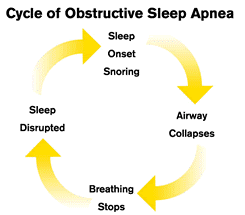
Think the typical person with sleep apnea looks like a beer gutted middle age man with a short fat neck?
Think again!
There is NO typical appearance of a person with obstructive sleep apnea, and here is why:
“Most people think of OSA as associated with obesity, but it’s now understood that it is not just obesity, but actually the anatomical structures of the upper airway that can cause obstructive sleep apnea.” explains Dr. C. Phillip Amoils, MD, a board certified otolaryngologist with SC-ENT Ear, Nose & Throat Specialists in CA.
Once you know the actual cause of obstructive sleep apnea, you’ll never again stereotype patients as being fat people with no necks.
Here’s what happens in obstructive sleep apnea.
Now you may be thinking, “Well gee, obesity causes that to happen.” But what you see in the illustration can occur to thin people, including young women and children.
It has to do with the anatomy we’re born with.
- This could be plus-size tonsils or a large uvula.
- It could be surplus throat tissue – which has nothing to do with obesity.
- It could be a tongue with a big base in combination with a small jaw.
- Or it could be structures that are just prone to excess laxity during sleep.
It can also be acquired via poor lifestyle choices. Smoking causes inflammation of the upper airway tissue. This can lead to obstruction during sleep.
Drinking liquor shortly before bedtime can cause upper airway structures to become way too relaxed, collapsing them — which compromises airflow down the throat.

“I could have sleep apnea.” Shutterstock/Kamira

“I could have sleep apnea.” Shutterstock/ShotPrime Studio

“I could have sleep apnea.” Freepik.com
Obesity is a major risk factor, not the ONLY risk factor.
Of course, obesity adds fat to the throat’s tissue, plumping it up and thereby making the airway smaller during sleep.
In cases of mild sleep apnea, weight loss can eliminate the problem for some patients.
But because obstructive sleep apnea is founded upon structural or anatomical issues, weight loss is not a cure for moderate and especially severe OSA.
- Loud snoring
- Paused breathing
- Gasping while asleep
- Snorting during sleep
- Frequent urination overnight
- Restless, fidgeting sleep
- Frequent awakenings
- Waking unrefreshed
- Jaw soreness on waking
- Dry mouth on waking
- Sore throat on waking
- Morning headaches
- Poor concentration
- Reduced attention span
- Irritability or moodiness
- Brain fog
- Hypertension that doesn’t respond to treatment
- Daytime fatigue
- Frequent naps watching TV
- Dozing off when driving










































